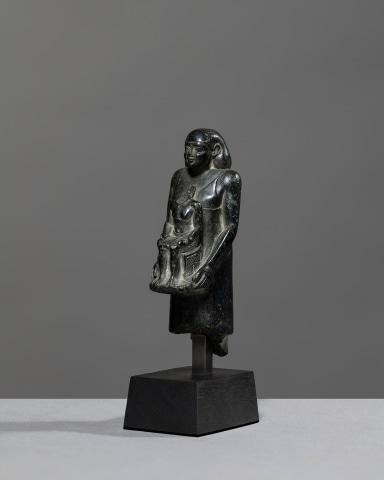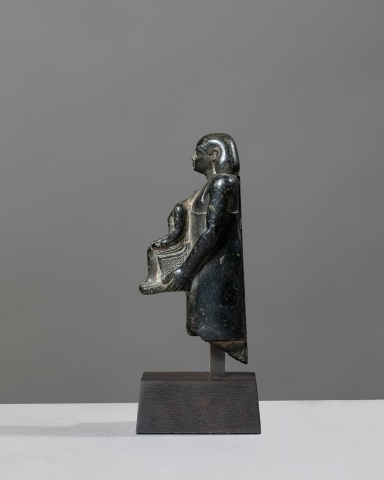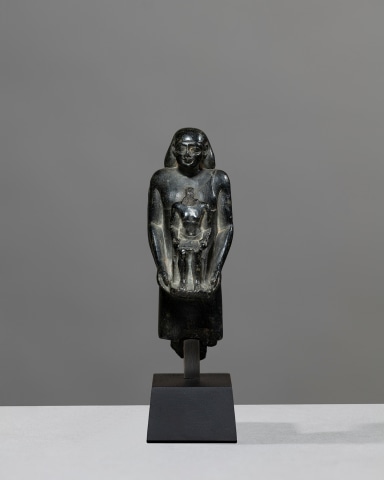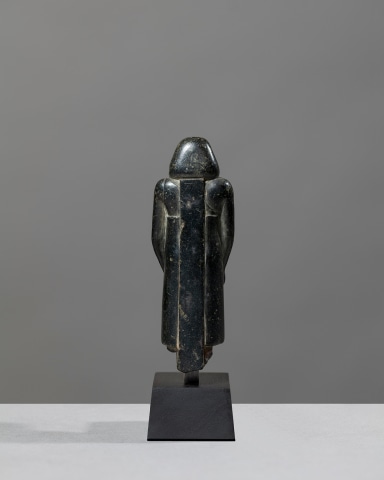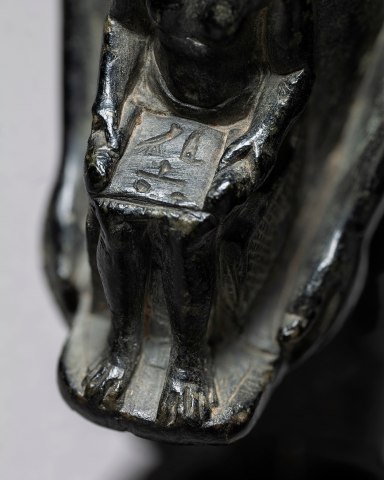Egyptian theophorous figure, holding a seated statuette of Imhotep, Late Dynastic Period, 27th-30th Dynasty, c.525-343 BC
Steatite
Height: 9.5cm
11789 IVP
£ 26,000
Further images
Statuette of a figure bearing an enthroned Imhotep, who in turn has a scroll on his lap bearing his name in hieroglyphs. The main figure holds the seated deity in...
Statuette of a figure bearing an enthroned Imhotep, who in turn has a scroll on his lap bearing his name in hieroglyphs. The main figure holds the seated deity in front of his chest, with both hands. He wears a bag wig, tucked behind his ears, his arms and one pectoral are bare, the other is covered by an animal pelt that is draped over his proper left shoulder, a tubular garment hangs from beneath his chest to just above the knees. The figure's hands extend forward to support the underside of the divine Imhotep's throne, with each finger individually rendered. The deity is seated on a decorated chair, with incised motifs on either side. A papyrus scroll rests in his lap, inscribed with hieroglyphs reading Imhotep. Carved in the round, the piece includes an uninscribed dorsal pillar at the back. Minor scuffing and chips, the head of the deity broken off, the lower section of the statuette broken away, otherwise intact.
The term theophorous, meaning "god bearer" in Greek, refers to a type of sculpture in which the subject carries a small figure of a deity, symbolizing the dedicant's devotion to or personal connection with the god. In this example, the male figure—draped in an animal skin over one shoulder—holds a seated statuette of the god Imhotep. The identity of the deity is confirmed by the hieroglyphic inscription on the papyrus scroll resting in his lap, with the text facing outward toward the viewer, as if the god is directly addressing the observer.
Imhotep was a prominent official during Egypt’s 3rd Dynasty in the Old Kingdom, who was posthumously deified and worshipped from the Late Period onwards—approximately two millennia after his death. In his lifetime, he served as a distinguished scholar, vizier to King Djoser, priest of Ptah, high priest of the sun god Ra, and is believed to have been the architect behind Djoser's Step Pyramid at Saqqara—the first pyramid constructed in Egypt. Revered as a patron of medicine, writing, and scholarship, Imhotep was commonly depicted as a scribe, shown with a skull-cap or shaven head and holding a papyrus scroll. This sculpture likely served as a votive offering in a temple or sanctuary dedicated to the god.; R.H. Wilkinson notes that Imhotep's 'cult centres were places of pilgrimage for sufferers who prayed and slept there in the hope that the god would heal them or reveal remedies to them through inspired dreams' (The Complete Gods and Goddesses of Ancient Egypt, London, 2003, p. 113).
The term theophorous, meaning "god bearer" in Greek, refers to a type of sculpture in which the subject carries a small figure of a deity, symbolizing the dedicant's devotion to or personal connection with the god. In this example, the male figure—draped in an animal skin over one shoulder—holds a seated statuette of the god Imhotep. The identity of the deity is confirmed by the hieroglyphic inscription on the papyrus scroll resting in his lap, with the text facing outward toward the viewer, as if the god is directly addressing the observer.
Imhotep was a prominent official during Egypt’s 3rd Dynasty in the Old Kingdom, who was posthumously deified and worshipped from the Late Period onwards—approximately two millennia after his death. In his lifetime, he served as a distinguished scholar, vizier to King Djoser, priest of Ptah, high priest of the sun god Ra, and is believed to have been the architect behind Djoser's Step Pyramid at Saqqara—the first pyramid constructed in Egypt. Revered as a patron of medicine, writing, and scholarship, Imhotep was commonly depicted as a scribe, shown with a skull-cap or shaven head and holding a papyrus scroll. This sculpture likely served as a votive offering in a temple or sanctuary dedicated to the god.; R.H. Wilkinson notes that Imhotep's 'cult centres were places of pilgrimage for sufferers who prayed and slept there in the hope that the god would heal them or reveal remedies to them through inspired dreams' (The Complete Gods and Goddesses of Ancient Egypt, London, 2003, p. 113).
Provenance
Ernest Brummer (1891-1964), Paris, FranceHis sale; Sotheby's, London, 16th-17th November 1964
His sale; Koller, Zurich, 16th-19th October 1979
Resandro collection, Europe; acquired at the above sale (R-414 (HP 6))
Exhibitions
Staatliche Sammlung Ägypischer Kunst, Munich, Germany, 'Entdeckungen, Ägyptische Kunst in Süddeutschland', 30th August-6th October 1985Ägyptisches Museum und Papyrussammlung, Berlin, Germany; Staatliche Museen zu Berlin, Germany; Staatliche Sammlung Ägyptischer Kunst Munchen, Munich, Germany; Museum für Kunst und Gewerbe Hamburg, Hamburg, Germany, 'Gott und Götter im Alten Ägypten', 1992-1993
Literature
Compare two examples of theophorous statues in the British Museum, London, acc. nos. EA 55254 and 41560Publications
Sotheby's, London, UK The Ernest Brummer Collection of Egyptian & Near Eastern Antiquities and Works of Art, 16th-17th November 1964, lot 93D. Wildung, Imhotep und Amenhotep, Gottwerdung im alten Ägypten, Münchner Ägyptologische Studien (MÄS) 36, (Berlin, Munich, 1977) p.40, no.18, pl.4,3
Spink & Son and Galerie Koller, Grand Hotel Dolder, Zurich, The Ernest Brummer Collection, Vol.II, 16th-19th October 1979, lot 522
S. Schoske and D. Wildung, Entdeckungen, Ägyptische Kunst in Süddeutschland (Munich, 1985), p.125, p.128, no. 107.
S. Schoske and D. Wildung, Gott und Götter im Alten Ägypten, (Mainz am Rhein, 1992), pp.188-189, no. 122.
I. Grimm-Stadelmann (ed.), Aesthetic Glimpses, Masterpieces of Ancient Egyptian Art, The Resandro Collection, (Munich, 2012), p.145, no.R-414
